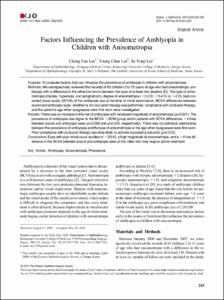Factors Influencing the Prevalence of Amblyopia in Children with Anisometropia
- Keimyung Author(s)
- Lee, Chong Eun; Lee, Se Youp
- Department
- Dept. of Ophthalmology (안과학)
- Journal Title
- Korean Journal of Ophthalmology
- Issued Date
- 2010
- Volume
- 24
- Issue
- 4
- Keyword
- Amblyopia; Anisometropia; Prevalence
- Abstract
- Purpose: To evaluate factors that can influence the prevalence of amblyopia in children with anisometropia. Methods: We retrospectively reviewed the records of 63 children 2 to 13 years of age who had anisometropic amblyopia with a difference in the refractive errors between the eyes of at least two diopters (D). The type of anisometropia (myopia, hyperopia, and astigmatism), degree of anisometropia (<2-3 D, <3-4 D, or >4 D), best corrected visual acuity (BCVA) of the amblyopic eye at the time of initial examination, BCVA differences between sound and amblyopic eyes, whether or not occlusion therapy was performed, compliance with occlusion therapy, and the patient’s age when eyeglasses were first worn were investigated. Results: There was an increase in the risk of amblyopia with increased magnitude of anisometropia (p=0.021). The prevalence of amblyopia was higher in the BCVA <20/40 group and in patients with BCVA differences >4 lines between sound and amblyopic eyes (p=0.008 and p=0.045, respectively). There was no statistical relationship between the prevalence of amblyopia and the type of anisometropia or the age when eyeglasses were first worn. Poor compliance with occlusion therapy was less likely to achieve successful outcome (p=0.015). Conclusions: Eyes with poor initial visual acuities of <20/40, a high magnitude of anisometropia, and a >4 line difference
in the BCVA between sound and amblyopic eyes at the initial visit may require active treatment.
- Publisher
- School of Medicine
- Citation
- Chong Eun Lee et al. (2010). Factors Influencing the Prevalence of Amblyopia in Children with Anisometropia. Korean Journal of Ophthalmology, 24(4), 225–229. doi: 10.3341/kjo.2010.24.4.225
- Type
- Article
- ISSN
- 1011-8942
- Appears in Collections:
- 1. School of Medicine (의과대학) > Dept. of Ophthalmology (안과학)
- 파일 목록
-
-
Download
 oak-aaa-03464.pdf
기타 데이터 / 339.55 kB / Adobe PDF
oak-aaa-03464.pdf
기타 데이터 / 339.55 kB / Adobe PDF
-
Items in Repository are protected by copyright, with all rights reserved, unless otherwise indicated.